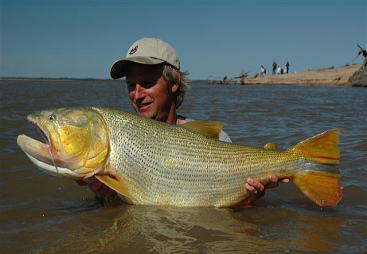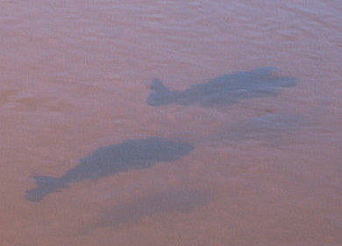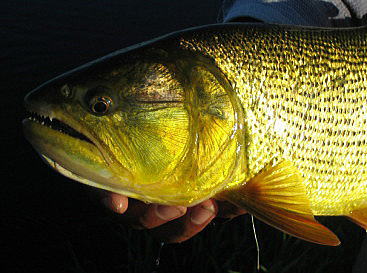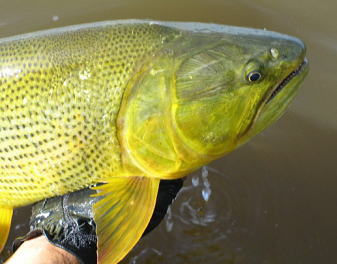Dorado are believed to spawn in early summer. Fingerings have an ordinary,
silver coloration and gain the golden shine gradually as they grow up.
In the muddy waters of Parana and lower Corrientes, they look more yellowish.
In the clear water of upper Corrientes and Ibera, the gold gains a metallic
luster and the dark green on the back adds to the savage beauty.
Thankfully, the conservation effort here seems beginning to pay off. In
2005, the all-tackle record of 51lb, which had stood for 21years, was broken
by a 53lb monster. Even with a fly, a trophy of 50lb (22.9kg) was caught
and released on a 8wt rod.
Dorado fishing is like a gamble. But the money lost is a small investment
that supports our precious game field. Under that premise, well, why not
go try your luck?
- Back
Rio Corrientes, Where we fished, is a tributary of Parana. Water rises from late spring
to summer. This triggers the spawning migration of bait fish, and that
of the predators behind. These rivers are considerably narrower, making
casting much easier, though the higher fishing pressure means less chance
of catching big ones at the same time.
Browsing the ads, you may be dazzled to see those great tales and pictures.But
according to our own experience, you are lucky to get one Dorado strike
for an hour's hard work. And again half of them end up missed or lost,
so the number of fish you actually catch is 2 or 3 per day at best. Many
anglers around and ourselves had blank days too and this is the reality
of the so called best season fishing. The size is another subject of marketing
hype. The average as far as we judge was 40-50cm weighing 2-4 pounds. When
you catch a fish of 70cm+ weighing 7lbs, that's a good day. Some ads dare
hint at the possibility of 20pounder, but even our guide, Peto, who has
fished the river since his childhood and caught countless number of dorados,
says he hasn't yet nailed down a 20lbs in the area. On the other hand,
another guide, a young lad in his 20's, said on his 2nd day of fishing
practice, a 21pounder grabbed his fly!!



Though called a 'river', Rio Parana is so big, with width up to 3kms, that
it may defy your image of a river. In most cases you would have to rely
on trolling to cover the broad expanse of the muddy water.
The best season to fish these spots is said to be the winter, when the
water gets lowest. A friend of mine who ventured out there in August successfully
landed this grand prize, weighing close to 15pounds!
Salminus Maxillosus in Latin, the fish is categorized as a member the extensive
Characin family and the relatives include Piranha in Amazon as well as
Tigerfish in Africa. Despite the physical resemblance, salmon form their
own Salmonids family and not a direct kin of Dorado - academically at least.
It is an intriguing subject how the similarity were inherited or developed
on the other sides of the equator.
The habitat includes Brazil, Bolivia, Paraguay, Uruguay and Argentine.
Despite the popular image, they do not live in the tropical Amazon proper,
and within Brazil, live only in the southern state of Matto Grosso. The
mecca and the homeground of dorado is still the La Plata river systems
in the north Argentine.

Also called 'Tigre de rio', i.e. the
tiger of the river, dorado is a voracious predator and one of the most
highly acclaimed game fish of the world.
The magnificent golden body and the awesome battle they produce have long
since becoming a legend of the Parana, one of the best known Dorado fisheries.




